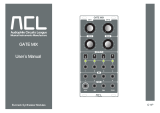
Sculpting Timbre with tELHARMONIC: Moving CENTROID w/ FLUX
The tELHARMONIC has 3 independent and simultaneously available Algorithms, each with a unique timbre. Using
two control voltages and a Gate signal, full timbral animation of the tELHARMONIC is possible. Because the Noise,
Harmonic and Phase Mod algorithms all respond quite dierently to these parameters, the results may be very
complex, and it is also possible to have some voices deeply modulated while other voices are not modulated at all.
The single voice Noise Algorithm, N-OUT, is inspired by the Music III patch that composer James Tenney wrote at
Bell Labs in 1961 for his rst computer music piece, “Analog 1: Noise Study.” It consists of two band-limited noise
sidebands, which surround the frequency set by TONIC and DEGREE. FLUX controls the width of the sidebands,
which can go from extremely narrow (for a uttering sinusoid) to full bandwidth. Using these two controls almost
any color of noise may be generated.
For the Harmonic Algorithm, H-OUT, each of the three voices is a 24-partial harmonic oscillator, using
high-resolution sine wave generators. The timbre is varied by the CENTROID and FLUX parameters, with
CENTROID setting the loudest of the 24 harmonics and FLUX setting the steepness of the gain roll-o around that
center harmonic. When FLUX is full CCW (0% modulation), the spectrum is at and sweeping the CENTROID will
ripple the spectrum (like a string harmonic). When FLUX is increased, the harmonics surrounding the CENTROID
decrease in amplitude and the sound becomes more focused upon the center harmonic, which causes modulation
of the CENTROID to have a more dramatic eect.
When FLUX is not set to 0%, a Trigger or Gate in the H-LOCK INput or a [PRESS] of the H-LOCK button will cause the
partial that is currently selected by the CENTROID parameter to be locked ON at full amplitude even after
CENTROID changes. By sequencing CENTROID and Locking harmonics, many additive timbres can be found. To
clear all locked harmonics, [HOLD] the H-LOCK button for 1 second or set Flux to 0% via panel control or CV. This
parameter aects all three voices of the H-OUT, but does not aect the P or N OUTs.
Each voice of the Phase-Modulation Algorithm uses 3, phase-locked, sine wave oscillators, arranged as 2
Modulators and 1 Carrier. This algorithm will create a large number of harmonically-locked partials by reshaping
the Carrier (similar to wavefolding). The CENTROID controls the frequency ratio of the modulation, and therefore,
the brightness. The FLUX controls the Depth of Modulation, which determines the number of partials. When FLUX
is full CCW, this is the largest number of partials; when full CW, there is only 1-- a sine wave. The CENTROID
controls 2 adjacent harmonic modulation partials from 1 to 8. For example, when CENTROID is at 2.5, the
Modulator will be an even mix of harmonics 2 and 3.






















